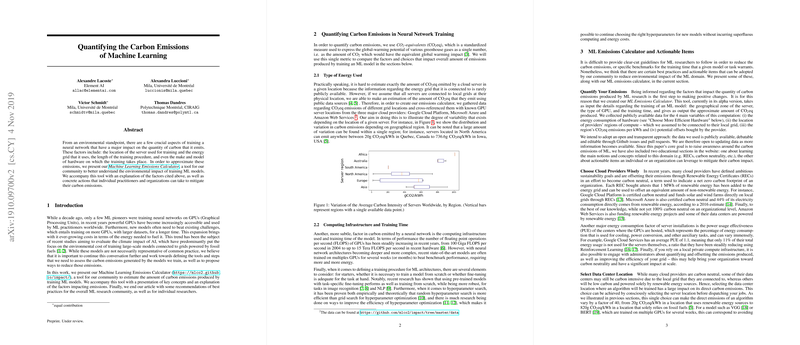Quantifying the Carbon Emissions of Machine Learning
The computing community has increasingly recognized the environmental impact of ML processes, particularly concerning carbon emissions during neural network training. This paper provides a quantitative analysis of the carbon emissions associated with ML model training, alongside a tool, the Machine Learning Emissions Calculator, designed to estimate these emissions. The authors focus on three primary factors influencing emissions: the energy source of the training servers, the duration of the training procedures, and the computational efficiency of the hardware used.
Key Factors Affecting Carbon Emissions
Energy Source Variability
The energy source at a given server's location significantly influences emission levels. The authors compiled emissions data for servers from major cloud providers, including Google Cloud Platform, Microsoft Azure, and Amazon Web Services, cross-referencing these with local energy grid data. The paper highlights stark differences in carbon intensity based on location, such as 20g CO₂eq/kWh in Quebec, Canada, vs. 736.6g CO₂eq/kWh in Iowa, USA. These results underscore the critical impact of server location on carbon emissions.
Hardware and Training Duration
The paper also evaluates the role of computing infrastructure, noting advancements in GPU capabilities from 100 GFLOPS in 2004 to up to 15 TFLOPS in modern hardware. Despite these improvements, more complex neural network models necessitate prolonged and resource-intensive training sessions on multiple GPUs, thus amplifying energy consumption. The authors propose alternative approaches, such as fine-tuning pre-trained models and employing random hyperparameter search, to reduce training times and conserve energy.
The Machine Learning Emissions Calculator
To address these concerns, the authors introduce the Machine Learning Emissions Calculator, a practical tool allowing researchers to estimate the carbon footprint of their training processes. By inputting details such as server location, GPU type, and training duration, practitioners can gain awareness of their environmental impact and adopt strategies to mitigate it.
Recommendations for Reducing Emissions
The paper outlines several actionable measures for mitigating carbon emissions in ML research:
- Select Environmentally Friendly Cloud Providers: Opt for providers with robust sustainability measures, such as those purchasing Renewable Energy Certificates (RECs) to offset carbon emissions.
- Use Energy-Efficient Data Centers: Choosing data centers in regions with low-carbon energy sources can significantly reduce emissions.
- Adopt Efficient Training Approaches: Avoid grid search for hyperparameter tuning, prefer random search, and conduct thorough literature reviews to minimize resource wastage.
- Utilize Efficient Hardware: Hardware selection can influence emissions, with TPUs providing higher GFLOPS/W compared to traditional GPUs, leading to energy savings.
Implications and Future Directions
This research prompts the ML community to integrate sustainability into their evaluation criteria, encouraging practices that balance scientific progress with environmental stewardship. Future efforts could extend beyond training to include model deployment emissions, recognizing the need for comprehensive lifecycle analyses of AI systems.
By quantifying and openly discussing carbon emissions, the authors contribute to an essential discourse on making AI more sustainable. Their emissions calculator represents a step toward actionable change, fostering an informed community equipped to make environmentally conscious decisions. This focus on sustainability is likely to influence future AI research agendas, stressing the importance of developing efficient computing paradigms that also consider ecological impact.
